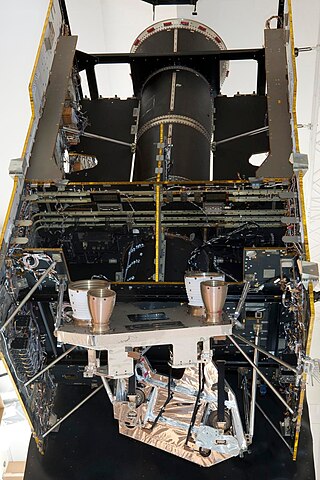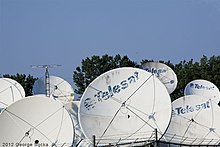
A communications satellite is an artificial satellite that relays and amplifies radio telecommunication signals via a transponder; it creates a communication channel between a source transmitter and a receiver at different locations on Earth. Communications satellites are used for television, telephone, radio, internet, and military applications. Many communications satellites are in geostationary orbit 22,236 miles (35,785 km) above the equator, so that the satellite appears stationary at the same point in the sky; therefore the satellite dish antennas of ground stations can be aimed permanently at that spot and do not have to move to track the satellite. Others form satellite constellations in low Earth orbit, where antennas on the ground have to follow the position of the satellites and switch between satellites frequently.

A satellite constellation is a group of artificial satellites working together as a system. Unlike a single satellite, a constellation can provide permanent global or near-global coverage, such that at any time everywhere on Earth at least one satellite is visible. Satellites are typically placed in sets of complementary orbital planes and connect to globally distributed ground stations. They may also use inter-satellite communication.

Skynet is a family of military communications satellites, now operated by Babcock International on behalf of the United Kingdom's Ministry of Defence (MoD). They provide strategic and tactical communication services to the branches of the British Armed Forces, the British intelligence agencies, some UK government departments and agencies, and to allied governments. Since 2015 when Skynet coverage was extended eastward, and in conjunction with an Anik G1 satellite module over America, Skynet offers near global coverage.
Loral Space & Communications Inc. is a Delaware-domiciled satellite communications company headed by Michael B. Targoff. The company was formed in 1996 from the remnants of Loral Corporation when Loral divested its defense electronics and system integration businesses to Lockheed Martin for $9.1 billion. In 2006, Bernard L. Schwartz retired after leading the company for 34 years.

The Anik satellites are a series of geostationary communications satellites launched for Telesat Canada for television, voice and data in Canada and other parts of the world, from 1972 through 2013. Some of the later satellites in the series remain operational in orbit, while others have been retired to a graveyard orbit. The naming of the satellite was determined by a national contest, and was won by Julie-Frances Czapla of Saint-Léonard, Québec. In Inuktitut, Anik means "brother".

The Nimiq satellites are a Canadian fleet of geostationary telecommunications satellites owned by Telesat and used by satellite television providers including Bell Satellite TV and EchoStar. 'Nimiq' is an Inuit word used for an object or a force which binds things together. A contest in 1998 was held to choose the name of these satellites. The contest drew over 36,000 entries. Sheila Rogers, a physiotherapist from Nepean, Ontario, submitted the winning name.

Viasat is an American communications company based in Carlsbad, California, with additional operations across the United States and worldwide. Viasat is a provider of high-speed satellite broadband services and secure networking systems covering military and commercial markets.
Astrium was an aerospace manufacturer subsidiary of the European Aeronautic Defence and Space Company (EADS) that provided civil and military space systems and services from 2006 to 2013. In 2012, Astrium had a turnover of €5.8 billion and 18,000 employees in France, Germany, the United Kingdom, Spain and the Netherlands. Astrium was a member of Institute of Space, its Applications and Technologies.
Galaxy 28 is a communications satellite owned by Intelsat located at 89° West longitude, serving the North America and South America market.
It was built by Space Systems/Loral, as part of its SSL 1300 line = . aka Galaxy 28 was formerly known as Telstar 8 and Intelsat Americas 8. This satellite provides services in the C-band, Ku-band, and Ka-band.

The Eurostar E3000 is a generic satellite model most commonly used for commercial and military communications satellites manufactured by Airbus Defence and Space. It is a member of Airbus Defence and Space's Eurostar family. It utilises a chemical, bi-propellant propulsion system for orbit raising and on-station manoeuvres with an optional plasma propulsion system (PPS). The PPS harnesses the Newtonian effect as a result of the ionisation of xenon gas employed by the use of Hall effect plasma thrusters. This system is most commonly used for north–south station-keeping. The E3000 was the first commercial satellite family to use lithium–ion batteries rather than the older nickel-based technologies for power supply during eclipses.
AMC-11 , previously GE-11, is an American geostationary communications satellite which is operated by SES It is currently positioned in geostationary orbit at a longitude of 131° West, from where it is used to relay cable television across North America for onward distribution. It broadcasts to Canada, the Caribbean, Mexico and the United States.

Telstar 12, previously known as Orion 2, is a Canadian communications satellite in the Telstar series which is operated by Telesat. It was originally built for Orion Network Systems, which merged with Loral Skynet shortly before the satellite was launched. It was subsequently transferred to Telesat when it merged with Loral Skynet in 2007.

MDA Ltd. is a Canadian space technology company headquartered in Brampton, Ontario, Canada, that provides geointelligence, robotics and space operations, and satellite systems.
The DirecTV satellite fleet is a group of communications satellites located at various geostationary orbits that DirecTV uses for their satellite television service and HughesNet internet service. The "DirecTV" prefix in their names has been changed to "T".

O3b is a satellite constellation in Medium Earth orbit (MEO) owned and operated by SES, and designed to provide low-latency broadband connectivity to remote locations for mobile network operators and internet service providers, maritime, aviation, and government and defence. It is often referred to as O3b MEO to distinguish these satellites from SES's forthcoming O3b mPOWER constellation.
Nimiq-5 is a Canadian communications satellite, operated by Telesat Canada as part of its Nimiq fleet of satellites. It is positioned in geostationary orbit at a longitude of 72.7° West of the Greenwich Meridian. As of July 2015, EchoStar Corporation leases the satellite's entire capacity to provide high-definition television direct-to-home broadcasting for Dish Network Corporation. When accessed using a multi-satellite receiver such as the VIP722k and a multi-satellite dish/LNB combo, such as the Dish-300, Dish-500, or Dish-Turbo 1000.4, the satellite is referred to by the on-screen diagnostics as Echostar 72 W.

Telstar is the name of various communications satellites. The first two Telstar satellites were experimental and nearly identical. Telstar 1 launched on top of a Thor-Delta rocket on July 10, 1962. It successfully relayed through space the first television pictures, telephone calls, and telegraph images, and provided the first live transatlantic television feed. Telstar 2 was launched May 7, 1963. Telstar 1 and 2—though no longer functional—still orbit the Earth.
ViaSat-1 is a high throughput communications satellite owned by Viasat Inc. and Telesat Canada. Launched October 19, 2011 aboard a Proton rocket, it held the Guinness record for the world's highest capacity communications satellite with a total capacity in excess of 140 Gbit/s, more than all the satellites covering North America combined, at the time of its launch.
Telstar 14R, also known as Estrela do Sul 2 is a commercial communications satellite in the Telstar series built by Space Systems/Loral for Telesat to provide Ku-band communications to South America and the Southern United States. It is a replacement for Telstar 14, whose north solar array failed to open after launch, limiting its mission effectiveness. Telstar 14R experienced the same problem, with its north solar array failing to open too, but is now in service despite that failure.
Telstar 14 or Estrela do Sul 1 is a commercial communications satellite in the Telstar series built by Space Systems/Loral (SS/L) for Telesat to provide Ku-band communications to South America and the Southern United States. Estrela do Sul 1 was launched by Sea Launch using a Zenit-3SL carrier rocket on 11 Jan 2004 for geosynchronous orbit at 63 degrees west.











